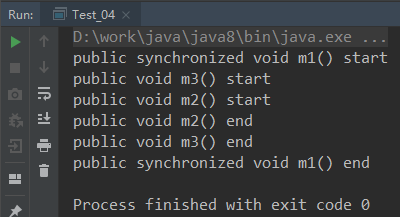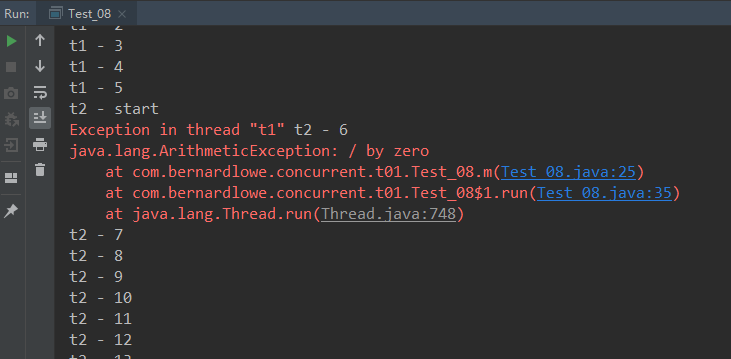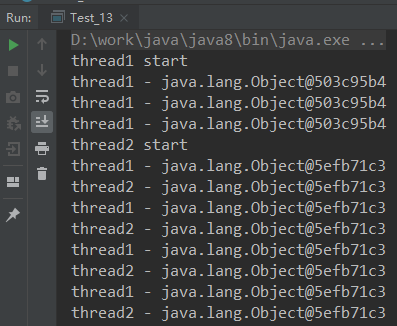1.为什么要使用synchronized?
在并发编程中存在线程安全问题,主要原因有:
1.存在共享数据
2.多线程共同操作共享数据。关键字synchronized可以保证在同一时刻,只有一个线程可以执行某个方法或某个代码块,同时synchronized可以保证一个线程的变化可见(可见性)
2.synchronized锁什么,加锁的目的是什么?
synchronized锁的是对象,锁的的对象可能是this、临界资源对象、class类对象
加锁的目的是保证操作的原子性
3.代码示例
3.1锁this和临界资源对象
本例中:
- testSync1是synchronized代码块,锁的是object,临界资源对象
- testSync2和testSync3都是锁的是当前对象this
1
2
3
4
5
6
7
8
9
10
11
12
13
14
15
16
17
18
19
20
21
22
23
24
25
26
27
28
29
30
31
32
33
34
35
36
37
38
39
40
41
42
43
44
45
46
47
48
49
50
51
52
53
54
55
56
57
|
package com.bernardlowe.concurrent.t01;
import java.util.concurrent.TimeUnit;
public class Test_01 {
private int count = 0;
private Object object = new Object();
public void testSync1(){
synchronized(object){
System.out.println(Thread.currentThread().getName()
+ " count = " + count++);
}
}
public void testSync2(){
synchronized(this){
System.out.println(Thread.currentThread().getName()
+ " count = " + count++);
}
}
public synchronized void testSync3(){
System.out.println(Thread.currentThread().getName()
+ " count = " + count++);
try {
TimeUnit.SECONDS.sleep(3);
} catch (InterruptedException e) {
e.printStackTrace();
}
}
public static void main(String[] args) {
final Test_01 t = new Test_01();
new Thread(new Runnable() {
@Override
public void run() {
t.testSync3();
}
}).start();
new Thread(new Runnable() {
@Override
public void run() {
t.testSync3();
}
}).start();
}
}
|
3.2锁class类对象
1
2
3
4
5
6
7
8
9
10
11
12
13
14
15
16
17
18
19
20
21
22
23
24
25
26
27
28
29
30
31
32
|
package com.bernardlowe.concurrent.t01;
import java.util.concurrent.TimeUnit;
public class Test_02 {
private static int staticCount = 0;
public static synchronized void testSync4(){
System.out.println(Thread.currentThread().getName()
+ " staticCount = " + staticCount++);
try {
TimeUnit.SECONDS.sleep(3);
} catch (InterruptedException e) {
e.printStackTrace();
}
}
public static void testSync5(){
synchronized(Test_02.class){
System.out.println(Thread.currentThread().getName()
+ " staticCount = " + staticCount++);
}
}
}
|
3.3 什么时候锁临界资源,什么时候锁当前对象?
如果在加锁的时候需要对当前对象的访问限定,建议锁临界资源(即锁一个临界资源),如果对当前锁级别比较高的话,就锁当前对象。建议都以同步代码块的方式进行开发,这样可以避免锁的范围太高
同步方法和非同步方法
提问:同步方法是否影响其他线程调用非同步方法,或调用其他锁资源的同步方法?
代码示例
m1是非同步方法,m2是同步方法,m3同步代码块,锁的临界资源,这段代码的目的是为了证明在调用同步方法m1时,m2,m3是否能够执行
1
2
3
4
5
6
7
8
9
10
11
12
13
14
15
16
17
18
19
20
21
22
23
24
25
26
27
28
29
30
31
32
33
34
35
36
37
38
39
40
41
42
43
44
45
46
47
48
49
50
51
52
53
54
55
56
57
58
59
60
61
62
63
64
65
66
67
68
|
package com.bernardlowe.concurrent.t01;
public class Test_04 {
Object o = new Object();
public synchronized void m1(){
System.out.println("public synchronized void m1() start");
try {
Thread.sleep(3000);
} catch (InterruptedException e) {
e.printStackTrace();
}
System.out.println("public synchronized void m1() end");
}
public void m3(){
synchronized(o){
System.out.println("public void m3() start");
try {
Thread.sleep(1500);
} catch (InterruptedException e) {
e.printStackTrace();
}
System.out.println("public void m3() end");
}
}
public void m2(){
System.out.println("public void m2() start");
try {
Thread.sleep(1500);
} catch (InterruptedException e) {
e.printStackTrace();
}
System.out.println("public void m2() end");
}
public static class MyThread01 implements Runnable{
public MyThread01(int i, Test_04 t){
this.i = i;
this.t = t;
}
int i ;
Test_04 t;
public void run(){
if(i == 0){
t.m1();
}else if (i > 0){
t.m2();
}else {
t.m3();
}
}
}
public static void main(String[] args) {
Test_04 t = new Test_04();
new Thread(new MyThread01(0, t)).start();
new Thread(new MyThread01(1, t)).start();
new Thread(new MyThread01(-1, t)).start();
}
}
|
执行结果

可以看出,在执行同步方法m1时,m2,m3不受影响,依然可以执行
结论:同步方法只影响锁定同一个锁对象的同步方法。不影响其他线程调用非同步方法,或调用其他锁资源的同步方法。
但有一点需要注意,尽量在商业开发中避免同步方法。使用同步代码块。 细粒度解决同步问题。
3.3 重入锁
这里重入锁分为两类:
- 1.在同步方法里面调用其他同步方法
- 2.子类同步方法覆盖父类同步方法
下面来看第一种:在同步方法里面调用其他同步方法
思考:调用m1()方法,m2()方法是否会执行?
1
2
3
4
5
6
7
8
9
10
11
12
13
14
15
16
17
18
19
20
21
22
23
24
25
26
27
28
29
30
31
32
33
34
35
36
37
|
package com.bernardlowe.concurrent.t01;
import java.util.concurrent.TimeUnit;
public class Test_06 {
synchronized void m1(){
System.out.println("m1 start");
try {
TimeUnit.SECONDS.sleep(2);
} catch (InterruptedException e) {
e.printStackTrace();
}
m2();
System.out.println("m1 end");
}
synchronized void m2(){
System.out.println("m2 start");
try {
TimeUnit.SECONDS.sleep(1);
} catch (InterruptedException e) {
e.printStackTrace();
}
System.out.println("m2 end");
}
public static void main(String[] args) {
new Test_06().m1();
}
}
|

结果:在m1()方法调用时,m2()方法依然可执行。多次调用同步代码,锁定同一个锁对象,是可重入的
第二种情况:子类同步方法覆盖父类同步方法
思考:子类同步方法m()中,调用父类同步方法m(),是否可重入?
1
2
3
4
5
6
7
8
9
10
11
12
13
14
15
16
17
18
19
20
21
22
23
24
25
26
27
28
29
30
31
32
33
34
35
36
|
package com.bernardlowe.concurrent.t01;
import java.util.concurrent.TimeUnit;
public class Test_07 {
synchronized void m(){
System.out.println("Super Class m start");
try {
TimeUnit.SECONDS.sleep(1);
} catch (InterruptedException e) {
e.printStackTrace();
}
System.out.println("Super Class m end");
}
public static void main(String[] args) {
new Sub_Test_07().m();
}
}
class Sub_Test_07 extends Test_07{
synchronized void m(){
System.out.println("Sub Class m start");
super.m();
System.out.println("Sub Class m end");
}
}
|

结果:子类同步方法m()中,调用了父类同步方法m(),可以重入
3.4 锁与异常
思考:当同步方法或同步代码块中发生异常,是否会影响其他线程的执行?
下面来看一段代码
1
2
3
4
5
6
7
8
9
10
11
12
13
14
15
16
17
18
19
20
21
22
23
24
25
26
27
28
29
30
31
32
33
34
35
36
37
38
39
40
41
42
43
44
45
46
47
|
package com.bernardlowe.concurrent.t01;
import java.util.concurrent.TimeUnit;
public class Test_08 {
int i = 0;
synchronized void m(){
System.out.println(Thread.currentThread().getName() + " - start");
while(true){
i++;
System.out.println(Thread.currentThread().getName() + " - " + i);
try {
TimeUnit.SECONDS.sleep(1);
} catch (InterruptedException e) {
e.printStackTrace();
}
if(i == 5){
i = 1/0;
}
}
}
public static void main(String[] args) {
final Test_08 t = new Test_08();
new Thread(new Runnable() {
@Override
public void run() {
t.m();
}
}, "t1").start();
new Thread(new Runnable() {
@Override
public void run() {
t.m();
}
}, "t2").start();
}
}
|
这段代码中先运行了两个线程t1、t2,当其中一个线程发生异常时,另外一个线程是否能继续执行

结果:当同步方法中发生异常的时候,自动释放锁资源。不会影响其他线程的执行。
思考: 同步业务逻辑中,如果发生异常如何处理?
比如上面会发生异常的代码中,可以这样
1
2
3
4
5
6
7
| if(i == 5){
try {
i = 1/0;
} catch (Exception e) {
i = 0;
}
}
|
3.5 锁对象变更问题
代码示例:8
思考:当一个线程执行同步方法时,另一个线程修改了锁对象,是否还能执行同步代码块
1
2
3
4
5
6
7
8
9
10
11
12
13
14
15
16
17
18
19
20
21
22
23
24
25
26
27
28
29
30
31
32
33
34
35
36
37
38
39
40
41
42
43
44
45
46
47
48
49
50
|
package com.bernardlowe.concurrent.t01;
import java.util.concurrent.TimeUnit;
public class Test_13 {
Object o = new Object();
void m(){
System.out.println(Thread.currentThread().getName() + " start");
synchronized (o) {
while(true){
try {
TimeUnit.SECONDS.sleep(1);
} catch (InterruptedException e) {
e.printStackTrace();
}
System.out.println(Thread.currentThread().getName() + " - " + o);
}
}
}
public static void main(String[] args) {
final Test_13 t = new Test_13();
new Thread(new Runnable() {
@Override
public void run() {
t.m();
}
}, "thread1").start();
try {
TimeUnit.SECONDS.sleep(3);
} catch (InterruptedException e) {
e.printStackTrace();
}
Thread thread2 = new Thread(new Runnable() {
@Override
public void run() {
t.m();
}
}, "thread2");
t.o = new Object();
thread2.start();
}
}
|

结论:可以看出,其他线程依然可以执行同步方法
因为同步代码一旦加锁后,那么会有一个临时的锁引用执行锁对象,和真实的引用无直接关联。在锁未释放之前,修改锁对象引用,不会影响同步代码的执行。
注意:不要使用静态常量作为锁对象
如下代码,因为String常量池的问题,s1,s1是同一个对象,所以m1,m2方法锁的是也同一个对象,m1同步方法被执行后,m2方法不会被执行
1
2
3
4
5
6
7
8
9
10
11
12
13
14
15
16
17
18
19
20
21
22
23
24
25
26
27
28
29
30
31
32
33
34
35
36
37
38
39
40
41
42
43
44
45
46
|
package com.bernardlowe.concurrent.t01;
public class Test_14 {
String s1 = "hello";
String s2 = "hello";
void m1(){
synchronized (s1) {
System.out.println("m1()");
while(true){
}
}
}
void m2(){
synchronized (s2) {
System.out.println("m2()");
while(true){
}
}
}
public static void main(String[] args) {
final Test_14 t = new Test_14();
new Thread(new Runnable() {
@Override
public void run() {
t.m1();
}
}).start();
new Thread(new Runnable() {
@Override
public void run() {
t.m2();
}
}).start();
}
}
|
更多精彩内容:mrxccc